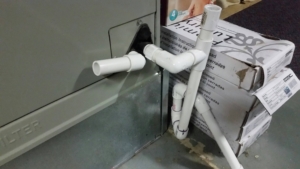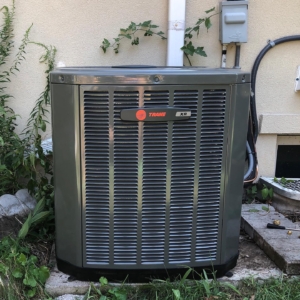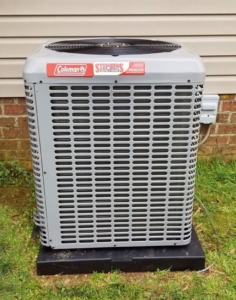Guide to Managing Indoor Humidity Levels
Managing indoor humidity levels is essential for a comfortable and healthy home environment. Excess moisture in the air can lead to health issues and damage to household materials and furnishings. On the other hand, low humidity levels can lead to dry skin, respiratory problems, and discomfort.
There are three main types of humidity: absolute, relative, and specific. Each type is measured differently.
- Absolute humidity is the amount of water vapor in a given volume of air, measured in grams of water vapor per cubic meter of air. This measurement is used mainly in scientific and industrial settings.
- The relative humidity is the most commonly used measure of humidity. It is the amount of water vapor in the air compared to the maximum amount it can hold at a given temperature, expressed as a percentage. For example, if the relative humidity is 50%, the air contains half the maximum amount of water vapor it can hold at that temperature.
- Specific humidity is the amount of water vapor in a given mass of air, measured in grams of water vapor per kilogram of air. This measurement is often used in meteorology.
Relative humidity is the most commonly used humidity measurement because it indicates how comfortable the air feels. High relative humidity can make the air feel stuffy and uncomfortable, while low relative humidity can lead to dry skin and respiratory problems. Humidity can be measured using a hygrometer to measure the amount of water vapor in the air.
Use a Dehumidifier to Manage Humidity Levels
/184856939-copy-56a343f15f9b58b7d0d12c9f.jpg)
Removing excess moisture from the air is one of the best ways to manage indoor humidity levels. Dehumidifiers help to remove excess moisture from your indoor environment comfortable and healthy.
A dehumidifier is an appliance that removes excess moisture from the air, helping to maintain optimal humidity levels indoors. It works by drawing in humid air, passing it over a cooling coil, and collecting the resulting condensation in a water tank.
Here are the top 5 dehumidifiers currently available for sale on Amazon.com, based on customer ratings and reviews:
- hOmeLabs 4,500 Sq. Ft Energy Star Dehumidifier – This dehumidifier is designed for larger spaces and can remove up to 50 pints of moisture from the air per day. It has a user-friendly control panel and an auto-defrost function to prevent ice buildup.
- TOSOT 1,500 Sq. Ft. Dehumidifier – This dehumidifier can remove up to 30 pints of moisture from the air daily and has a compact design that makes it easy to move around. It also features an automatic shut-off function to prevent overfilling of the water tank.
- Vacplus 1,500 Sq. Ft. Dehumidifier – This dehumidifier can remove up to 30 pints of moisture from the air daily; it has a sleek design that blends in with any decor. It features a built-in humidistat and an auto-shutoff function when the water tank is full.
- Pro Breeze Electric Mini Dehumidifier – This small dehumidifier is perfect for use in small spaces such as closets, bathrooms, and RVs. It can remove up to 18 ounces of moisture from the air daily and has a compact design that makes it easy to move around.
- SEAVON Electric Dehumidifier for Home – This dehumidifier can remove up to 16 ounces of moisture from the air daily and has a portable design that makes it easy to move around. It features an auto-shutoff function and an LED indicator to tell when the water tank is full.
Pros and Cons of using a dehumidifier:
Pros:
- Prevents mold and mildew growth: Excess moisture in the air can lead to mold and mildew growth, which can cause health problems and damage to your home. A dehumidifier can remove excess moisture from the air, preventing mold and mildew growth.
- Improves indoor air quality: High humidity levels can cause musty odors and poor indoor air quality. A dehumidifier can help to remove excess moisture, improving the air quality in your home.
- Protects household items: High humidity levels can cause damage to household items such as furniture, clothing, and electronics. A dehumidifier can help to protect these items by reducing the moisture levels in your home.
- Reduces energy costs: A dehumidifier can help to reduce energy costs by making your home feel cooler and less humid. This means that you may be able to use your air conditioning less, saving you money on your energy bill.
Cons:
- High initial cost: Dehumidifiers can be expensive, especially if you need one that can handle a large space. This can be a significant investment for some homeowners.
- Ongoing maintenance: Dehumidifiers require regular maintenance to keep them functioning correctly. This includes cleaning the filters and emptying the water tank.
- Noise: Some dehumidifiers can be noisy, especially when the compressor is running. This can be a problem if you plan to use the dehumidifier in a bedroom or other quiet area.
- May increase energy costs: Although a dehumidifier can help reduce energy costs in some cases, it can also increase energy costs if you run it constantly. This is especially true if you have a large dehumidifier that uses energy.
Overall, the benefits of using a dehumidifier may outweigh the drawbacks for many homeowners, especially those who live in humid climates or have moisture issues.
Properly Ventilate Your Home to Improve Air Circulation
Good ventilation is essential for managing indoor humidity levels. You can improve air circulation by opening windows, using exhaust fans in bathrooms and kitchens, and installing vents in the attic and crawl space.
Fix Leaks to Prevent Excess Moisture from Entering Your Home
Leaks in the roof, walls, or plumbing can lead to excess moisture entering your home. It’s essential to fix any leaks as soon as you discover them to prevent excess moisture from causing damage.
Control Indoor Sources of Humidity
Cooking, showering, and doing laundry can contribute to excess moisture in your home. It’s essential to control indoor sources of humidity by using exhaust fans or opening windows to ventilate the area.
Use Air Conditioning to Reduce Indoor Humidity Levels
Air conditioning can help reduce indoor humidity levels by removing moisture from the air. Set the AC to a comfortable temperature while maintaining humidity levels between 30% to 50%.
Here are the steps to follow:
- Set your air conditioner to the “cool” mode and select a comfortable temperature. The recommended temperature range is between 70°F and 75°F.
- Ensure your air conditioner’s fan is set to “auto” mode instead of “on” mode. This will allow the AC to cool the air and remove excess moisture more effectively.
- If your air conditioner has a “dry” mode, use it. This mode operates the air conditioner at a lower fan speed to remove more moisture from the air.
- Regularly clean or replace the air filter in your air conditioner. A dirty air filter can reduce the effectiveness of your AC, leading to higher humidity levels.
- If your air conditioner has a programmable thermostat, set it to turn off when you are not at home. This will save energy and prevent excess moisture buildup in your home.
- Ensure your air conditioner is properly sized for the space you are trying to cool. An undersized unit may not be able to reduce indoor humidity levels effectively.
Incorporate Plants That Absorb Moisture into Your Home Decor

Plants can absorb moisture from the air, helping to reduce humidity levels and improve indoor air quality.
Here are ten plants that can help absorb moisture in your home:
- Boston fern (Nephrolepis exaltata) – Boston ferns are known for absorbing moisture from the air, making them a great addition to any humid room.
- Spider plant (Chlorophytum comosum) – Spider plants are easy to care for and have air-purifying properties that can help improve indoor air quality.
- Peace lily (Spathiphyllum wallisii) – Peace lilies are known for their ability andisture from the air, as well as toxins such as formaldehyde and benzene.
- English ivy (Hedera helix) – English ivy is a great plant for absorbing excess moisture and can also help remove toxins from the air.
- Bamboo palm (Chamaedorea seifrizii) – Bamboo palms are known for their ability to absorb moisture and can also help filter out pollutants from the air.
- Aloe vera (Aloe barbadensis) – Aloe vera plants are known for their healing properties and can help absorb excess moisture from the air.
- Snake plant (Sansevieria trifasciata) – Snake plants are low maintenance and can help remove excess moisture and toxins from the air.
- Rubber plant (Ficus elastica) – Rubber plants are great for absorbing excess moisture and can also help improve indoor air quality.
- Areca palm (Dypsis lutescens) – Areca palms are known for their ability to absorb moisture and can also help purify the air.
- Golden pothos (Epipremnum aureum) – Golden pothos are easy to care for and help remove excess moisture and toxins from the air.
Summary: Guide to Managing Indoor Humidity Levels
Managing indoor humidity levels can improve your home’s comfort, health, and energy efficiency. Remember to measure your indoor humidity levels regularly, use a dehumidifier, properly ventilate your home, fix leaks, control indoor sources of humidity, use air conditioning, and incorporate plants that absorb moisture into your home decor.
Here are the three resources for managing humidity levels in homes, along with their website links:
- Energy Star – The Energy Star program, run by the U.S. Environmental Protection Agency, provides various resources for managing indoor humidity levels. Their website offers information on the importance of indoor air quality and tips for improving ventilation and controlling moisture levels in your home. You can find their website at https://www.energystar.gov/products/ask-the-expert/heating-cooling-air-quality.
- American Society of Heating, Refrigerating and Air-Conditioning Engineers (ASHRAE) – ASHRAE is a professional organization focusing on improving indoor air quality and energy efficiency. Their website provides a range of resources for homeowners, including information on indoor air quality, ventilation, and humidity control. You can find their website at https://www.ashrae.org/technical-resources/resources.
- The National Institute of Standards and Technology (NIST) – NIST is a government agency that provides a range of resources for homeowners, including information on managing indoor humidity levels. Their website offers a variety of articles, guides, and publications related to indoor air quality and energy efficiency, as well as tools for measuring indoor humidity levels. You can find their website at https://www.nist.gov/topics/humidity.






Pingback: Air Conditioning Drainage Is Important, Learn Why – GGR Home Inspections